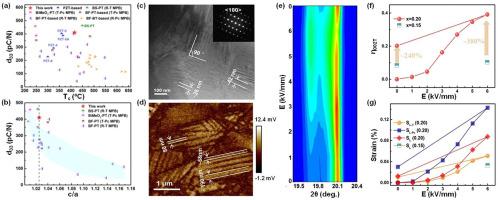Elaborately-designed high-performance BiFeO3-PbTiO3 ceramics through refreshing phase boundary
IF 8.3
1区 材料科学
Q1 MATERIALS SCIENCE, MULTIDISCIPLINARY
引用次数: 0
Abstract
The development of high-performance BiFeO3-PbTiO3 (BF-PT) piezoelectric compositions is highly desirable, but still challenged due to their high Curie temperature (Tc), large lattice distortion and octahedral tilt induced large antiferrodistortion in rhombohedral-tetragonal phase (R3c-P4mm) coexisted compositions. Here, a dual strategy by introducing the pseudo-cubic (Pc) phase in place of the R3c phase, and adjusting the lattice distortion of P4mm phase was realized in 0.60Bi0.95La0.05FeO3-(0.40-x)PbTiO3-xBaTiO3, where a large piezoelectric coefficient d33 of ∼410 pC/N, a high Tc of ∼416 °C as well as a good thermal stability can be achieved at x=0.20 composition. The structural analyses indicate that the superior piezoelectric activity should be associated with several factors including the coexistence of tetragonal (T) and Pc phases without octahedral tilt, the field-induced reversible T-Pc transition and the optimized c/a ratio. More pronouncedly, the extrinsic piezoelectric response induced by significantly enhanced domain wall motion contributes to almost ∼70 % of the quasi-static d33 value. Moreover, the robust domain texture up to ∼400 °C is responsible for its good thermal stability. These merits suggest giant potentials of the elaborately-designed composition as high-temperature piezoelectric materials.

通过刷新相界精心设计高性能 BiFeO3-PbTiO3 陶瓷
开发高性能 BiFeO3-PbTiO3(BF-PT)压电材料是非常理想的,但由于其居里温度(Tc)高、晶格畸变大以及八面体倾斜在斜方体-四方相(R3c-P4mm)共存材料中引起的反铁电体畸变大,因此仍然面临挑战。在这里,通过引入假立方(Pc)相代替 R3c 相,并调整 P4mm 相的晶格畸变,实现了在 0.60Bi0.95La0.05FeO3-(0.40-x)PbTiO3-xBaTiO3中,在x=0.20的组成条件下,可以获得较大的压电系数d33(∼410 pC/N)、较高的Tc(∼416 °C)以及良好的热稳定性。结构分析表明,卓越的压电活性与多个因素有关,包括四方(T)相和无八面体倾斜的 Pc 相共存、场诱导的可逆 T-Pc 转变以及优化的 c/a 比。更明显的是,由显著增强的畴壁运动引起的外压电响应几乎占准静态 d33 值的∼70%。此外,高达 ∼400 °C 的坚固畴纹也是其良好热稳定性的原因。这些优点表明,精心设计的成分具有作为高温压电材料的巨大潜力。
本文章由计算机程序翻译,如有差异,请以英文原文为准。
求助全文
约1分钟内获得全文
求助全文
来源期刊

Acta Materialia
工程技术-材料科学:综合
CiteScore
16.10
自引率
8.50%
发文量
801
审稿时长
53 days
期刊介绍:
Acta Materialia serves as a platform for publishing full-length, original papers and commissioned overviews that contribute to a profound understanding of the correlation between the processing, structure, and properties of inorganic materials. The journal seeks papers with high impact potential or those that significantly propel the field forward. The scope includes the atomic and molecular arrangements, chemical and electronic structures, and microstructure of materials, focusing on their mechanical or functional behavior across all length scales, including nanostructures.
 求助内容:
求助内容: 应助结果提醒方式:
应助结果提醒方式:


